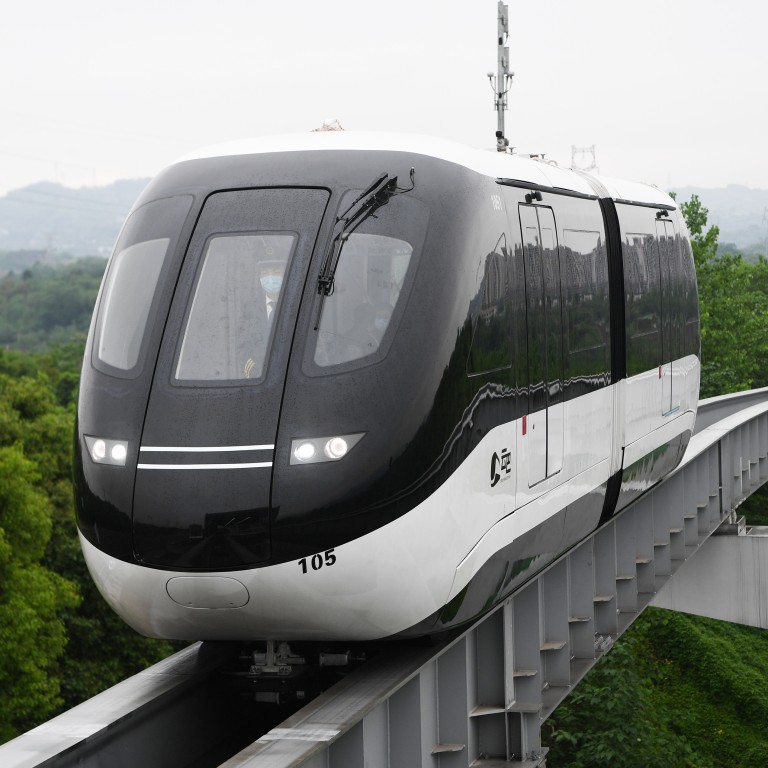
Stuck in Kai Tak: Hong Kong looks to Shenzhen for ways to ease transport woes in new business district
- As first residents move into former airport area, transport connections become pressing issue
- Lawmakers and developers optimistic driverless rail transit system can make difference
The 33-year-old considers himself lucky because there is a direct minibus service between his home and his workplace in Kowloon Bay.
Many of his neighbours, however, were unhappy with the public transport situation and have called for a mass transit system to connect them with Kai Tak MTR station, 2km (1.3 miles) away.

“Alternative commuting methods proposed by the government have yet to materialise,” Wong said. “Many residents are annoyed.”
Now there is hope that the area may get a driverless rail transit system along the lines of SkyShuttle, developed by Shenzhen-based BYD Auto.
Secretary for Transport and Logistics Lam Sai-hung on Wednesday said: “We will contact SkyShuttle to collect all relevant information and statistics … so that we can further analyse the applicability of SkyShuttle in Hong Kong.”

SkyShuttle runs on battery power and does not need a dedicated track, as its trains use tyres. Each train has between two and eight compartments, with each carrying 70 people.
Hong Kong leader open to using mainland-made transit link to revive monorail plan
The large Kai Tak area was left idle for years after the city’s international airport moved to Chek Lap Kok in 1998.
Under the Kai Tak development plan unveiled in 2011, the former airport runway area and the rest of East Kowloon would become a second business district, with the first being Central on Hong Kong Island.
It included a residential and commercial district with green spaces, a cruise terminal and a mega sports park with a 50,000-seat stadium. The cruise terminal opened in 2013.
A review in 2016 increased building density to help address the city’s housing crunch and several commercial sites were rezoned for homes.

Public transport has long been an issue for the area. In 2020, the authorities jettisoned a proposal for a 9km (29,527 foot) monorail cutting across the heart of Kowloon and the 320-hectare (790-acre) Kai Tak development area because of cost concerns.
Then development minister Michael Wong Wai-lun said the monorail idea, estimated to cost HK$12 billion, was financially non-viable and proposed instead a mix of electric vehicles, buses, travelators, water taxis and cycling paths.
Politicians argued that scrapping the monorail and reducing the number of commercial sites deviated from the original vision, and nine developers came together to pressure the government to provide transport facilities.
Hong Kong’s Kai Tak dreams fizzle amid delays, changes to plans
Several lawmakers who accompanied city leader Lee on his visit to BYD Auto last week suggested having a SkyShuttle system in Kai Tak and nearby East Kowloon.
One of them, Gary Zhang Xinyu, said: “It can break through the challenges that can’t be overcome by other monorail systems.”
He said a SkyShuttle system could take Kai Tak commuters to the MTR’s Tuen Ma line, Kwun Tong line and Tseung Kwan O line.
While light rail transit systems required double-track viaducts between 13 and 15 metres (42 and 49 feet) wide, SkyShuttle needed only six metres, he said.
End of line for Hong Kong light railway train class marked by special journey
He estimated that building a SkyShuttle line in Kai Tak might cost HK$7 billion, or HK$500 million per kilometre.
Stewart Leung Chi-kin, chairman of the Real Estate Developers Association, said a SkyShuttle system would be conducive to developing Kai Tak in the long run.
“When the government put the land parcels on sale, it promised to have a rapid transit system,” said Leung, a vice-chairman of Wheelock Properties, which has five development projects in the area. “The government suddenly cancelled it and has yet to find a substitute.”
He said the situation was not yet dire as only one residential project was ready. “But we will have 10 projects in future in the runway area that will house 30,000 people,” he said.
Hong Kong residents threaten to protest over public housing plan at Kai Tak site
Lau Chun-kong, chairman of the Hong Kong Institute of Surveyors’ land policy panel, welcomed the news that the government was finally considering a transit link in East Kowloon.
“The most important thing is to fulfil the needs of the residents in Kai Tak,” he said. “The government should do as much as it can. The planning in the area is unsatisfactory.”
Charles So Hung-tak, chairman of the logistics and transport division at the Hong Kong Institute of Engineers, said the SkyShuttle might work only in a relatively small community like Kai Tak where the route was short and straight.
“But I have reservations about whether the entire system can be copied from the mainland to Hong Kong because design standards differ between the two,” he said.
Hongkongers spurn latest flats in Kai Tak after temporary housing plan unveiled
He explained that it would cost more to have platform screen doors, which were a standard feature at Hong Kong’s new stations.
“In an emergency, passengers can leave the train compartments from the side doors, but SkyShuttle relies on doors at the front and rear for evacuation,” he said.
Lawmaker Wendy Hong Wen, head of research at New World Development, said introducing a mass transit system would have a positive impact on the property market in the area.
“As long as the local transport system is improved, it will be attractive to investors, residents and potential homebuyers,” she said.

